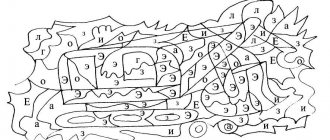Baby's cry - initial attempts at communication
All vocal reactions of the child can be divided into two groups:
- reflex sounds,
- socialized sounds.
Among the reflex ones, screams and sounds of pleasure are distinguished.
Already by the 2nd month of life, the baby’s cry begins to acquire more and more new shades, and by 3 months the mother can already determine why the baby is screaming: whether he is hungry, whether he is wet or something hurts. In all cases, the cry has its own characteristics.
In a healthy baby, the intonation coloring of a cry is clearly expressed starting from the 3rd month of life. In children who have suffered birth trauma, asphyxia during childbirth and other pathological conditions, the intonation features of a cry may be absent. The voice of such children is quiet and monotonous.
Disturbances in the development of intonation coloring of a cry are often combined with feeding difficulties. The baby may suck poorly, choke and choke during feeding, and sometimes milk leaks out of his nose. Such a baby should definitely be shown to a neurologist.
In the first months, the baby’s cry is dominated by vowel-like sounds that have a certain nasal connotation. These are sounds like “e”, “ay”. Sometimes the sounds resemble the consonants “g”, “k”, “n”. But since they are of a reflexive nature, they are not considered the predecessors of phonemes.
And yet, by pronouncing these sounds, the baby learns to coordinate the work of the respiratory, phonatory and articulatory muscles. The feedback between articulatory movements and their auditory perception also develops.
We recommend that you listen carefully to the baby's cry. The nature of the cry has important diagnostic significance. In a healthy baby of the 2nd month of life, the cry is loud, clear, with a short inhalation and an extended exhalation.
Children with damage to the central nervous system, who later develop speech disorders, may not cry in the first months. Either their scream is piercing, or, conversely, very quiet. As you exhale, the child sobs or screams. A significant nasal tone in the voice is also a sign of trouble.
If in a healthy baby the intonation features of a cry are formed by 3 months of life, then with organic damage to the central nervous system, for example, with cerebral palsy, the cry remains monotonous and inexpressive.
At 2-3 months, while crying in a healthy child, general uncoordinated movements of the arms and legs begin to intensify. The first tears appear. In addition, if during the newborn period the child screamed only from cold, hunger, discomfort and pain, then from 2 months he begins to scream indignantly if the mother stops communicating or changes his body position. From this age, a child often screams before going to bed from overexcitement.
⇡#First sound in the Universe
What was the very first sound? A simple question, but finding an answer to it is very, very difficult. Probably the first sound should have been born along with our Universe. If we adhere to the Big Bang theory, then the Universe, as it cooled (approximate age - 400 thousand years), was filled with gas. And if so, then sound could theoretically propagate in space. Of course, no one could hear it, but some space researchers are convinced that it can now be recreated. As a source of data from which one can imagine the processes that took place in the distant past, scientists propose taking a map of the cosmic microwave background radiation, a panorama with traces of the uneven cooling of the Universe. This unevenness is a consequence of sound vibrations, probably the first acoustic processes in our world.
Professor Mark Whittle from the University of Virginia became interested in this problem. Based on his analysis of the cosmic microwave background radiation, he created an audio that many dubbed the “cry of the birth of the universe.”
These cosmic sound waves, which Whittle synthesized on a computer, span 30,000 light years. So that they could be heard by the human ear, the scientist shifted the sound of the recording 55 octaves lower, into the audible range.
Despite the fact that Whittle was able to look into the past, he himself treats his experiment with humor. “Having listened to this record, I have to admit that the Universe is a lousy musical instrument,” Mark laughs. However, not everyone agrees with Whittle's statement.
First ASU
The sounds of pleasure, as we said, are also of a reflex nature. Usually after feeding or after you have changed a wet or dirty baby, you hear the sounds of contented grunting, satisfied grunting, hooting, humming or initial babbling. Among them, front vowels and back consonants are more common.
Unlike screams, they do not have a nasal connotation.
Experts believe that speech develops faster when hearing is stimulated by sounds of pleasure. The most important among them are humming and babbling.
⇡#Music of celestial bodies
Record label owners often talk about how damaged the music industry is today. Everything is wrong for them - the MP3 format has practically destroyed audio discs, and file-sharing networks are depriving them of profits, and radio stations do not make royalties for the use of music content. There is some truth in their words, although this issue is very, very controversial. Fans will always buy compositions by a good performer and in any format. Moreover, if the recording on the disc is unique, then it can arouse interest even among those who do not listen to music at all.
And here's an example - the National Aeronautics and Space Administration (NASA) contributed to the release of CDs with unusual music - space melodies performed by the cosmos itself and its celestial bodies.
To obtain “cosmic music”, scientists used several techniques. First, they used recordings of sound vibrations of charged particles that arose as a result of the interaction of the planet’s magnetosphere with the solar wind. In addition, the “voice” of the magnetosphere itself and the noise of the electromagnetic field in space were recorded. Electronic sensors also recorded the reaction of radio waves that were “trapped” and repeatedly reflected between the lower layer of the atmosphere and the planet itself. The “cosmic music” was also based on recordings of the process of emission of charged particles from the rings of some planets.
Most of the tunes that have been recorded on music CDs are processed data received from the legendary Voyager-1 and Voyager-2. These spacecraft, launched in 1977 as part of a project to study the distant planets of the solar system, still continue to amaze humanity.
⇡#Spacesounds navigator - space music
In the Solar System, as well as throughout the Universe, cosmic music sounds. Planets, comets, stars talk - to hear them, you just need to know where, how and what to listen. Sometimes the audio looks like chaos, sometimes it resembles the creations of famous experimentalists in electronic music, like Kraftwerk. Such cosmic sounds inspired the authors of the spacesounds.com project to create the Spacesounds navigator - an interactive map of sounds in the Solar System. You can view it online or download it to disk as a Flash application. It is enough to select an object of the Solar System on this map, and you will immediately hear the sounds it produces, recorded by spacecraft.
⇡#The Noise of Aurora: how to listen to the northern lights
At home and on the street we are surrounded by constant noise - a mixture of sounds of very different origins. Cars hum, leaves rustle, animal voices are heard, etc. All these are the sounds of life that fill the Earth. You can hear the voice of the Blue Planet even where, it would seem, there should be no sounds at all. For example, in the north, where you can often observe a very beautiful natural phenomenon - the northern lights. When the solar wind reaches the upper atmosphere, charged particles begin to interact with the Earth's magnetosphere, and the sky lights up with a glow. In addition, sometimes in silence you can hear unusual sounds that accompany this event. Usually they resemble a kind of tapping and quiet crackling.
Until a certain point, scientists believed that the source of such noise was high above the ground. However, in 2012 this assumption was refuted. In the region where the northern lights could be observed, Finnish scientists installed several microphones. When the aurora appeared and the noise was heard, it was recorded by instruments, and its source could be easily located. The point at which the sounds were born turned out to be only 70 meters above the surface of the Earth.
There is still no clear opinion among scientists as to exactly what physical processes cause this “melody” of the northern lights.
⇡#Sunny accent
This melody was recorded by the SOHO spacecraft, whose main task was to study the Sun. Its name stands for Solar and Heliospheric Observatory (“solar and heliospheric observatory”). In addition to various complex equipment, including ultraviolet radiation flux sensors, a Doppler shift meter, a wide-angle spectrometric coronagraph, an ultraviolet telescope and other instruments, the device is equipped with a device for observing low-frequency global oscillations of the Sun. It was with his help that we were able to record this audio file. It shows how atmospheric circulation inside the Sun produces very low-frequency sound.
A whole series of similar sounds was published on his university page by Stanford University scientist Alexander Kosovichev.
⇡#Flute in space: the first space duet
Heavenly sounds frighten, fascinate and evoke thoughtfulness. But the musical value of such a compilation, frankly speaking, is small. And here we completely agree with Mark Whittle’s statement that the Universe is not the most beautiful musical instrument. It is much more pleasant to listen to ordinary earthly music invented by man. And if you play it in space, it will also be “cosmic” in its own way.
NASA astronaut Catherine Coleman, while in Earth orbit, aboard the International Space Station, together with the famous musician Ian Anderson, founder of the rock band Jethro Tull, played the classical composition Bourree by Johann Sebastian Bach on the flute in 2011. The founder of the legendary group was on Earth at that time, on tour in Perm.
Ian and Catherine dedicated their performance to Cosmonautics Day and the 50th anniversary of the first manned space flight. Apart from the cheerful impromptu of the ancient song The Fountain in the Park (I was strolling on the Moon one day), which was performed by astronauts Harrison Schmitt and Eugene Cernan during their walk on the Moon, the Coleman-Anderson duet can be considered the first professional space performance.
Tongue twisters in English using the sound /ə/
Before practicing tongue twisters, watch this video. Do you remember at the beginning of this section of the article I wrote that the sound “schwa” is replaced by many sounds when the word is in a weak position? It is this feature of speech that creates the native speaker effect. After watching the video, try to apply this knowledge on tongue twisters.
- Can a d a is cold e r th a n Kore a , Kore a is hott e r than Can a d a .
- Debor a ’s fam ily is h e r fath e r a nd moth e r, Hel e n a ’s fam ily is h e r sist e r a nd broth e r.
- Jon a th a n a ddresses his lett e rs t o Nich o l a s, Nich o l a s a ddresses his lett e rs t o Jon a th a n.
And the last song example for today. – Ground C o ntrol t o
Maj o r Tom – is perfect .
Because, firstly, this sound occurs there 3 times and is clearly heard (as far as possible for a faceless “seam”), and secondly, the syllables with it are in a weak unstressed position in relation to the rhythm
songs:
Ground C o
ntról t
o
Máj
o
r Tom.
From 0:33 minutes. But listen to the whole song: it’s a masterpiece!
Summing up: how to improve English pronunciation yourself
- Short /ɪ/ is wider than ours: the tongue is pulled back more strongly, the back of the tongue rises, but lower; the mouth is more relaxed (almost like for our E); the sound is shorter. A bit reminiscent of the Russian sound IE, as in the word h e
tyre. - Long /i:/ is also wider than ours (but not as wide as short ɪ), and longer than ours. Mouth in a “smile” position. This is a diphthongoid sound: the back of the tongue slides forward and upward during pronunciation, so the “overtone of two sounds” is heard.
- The sound /e/ is shorter and more closed than ours: the middle back of the tongue rises higher to the palate and moves more forward, the jaws are placed closer to each other.
- The unstressed neutral sound “shva” does not need to be pronounced like the Russian / e /. It is pronounced in a completely relaxed position: the tongue is in the middle, the mouth is not tense. The analogue in Russian is post-stress and 2nd pre-stress A, O or E.
Fifth relationship of sounds
What all natural musical sounds have in common is the presence of pronounced octave and fifth overtones in their timbre. Let's compare the sounds located at these intervals. Let's take a sound (top half), and then an octave from it (bottom half of the picture below). The brain understands that it has already heard such a sound, an octave, as the loudest, the first overtone of the previous sound (1 in the top picture). The harmonic frequencies of the new one repeat the same frequencies of the old one, only proportionally 2 times higher. Musicians denote sounds at an octave distance with one note (here it is Bb).
Sound and octave from it. The numbers are the numbers of their overtones. The 1st overtone of the first sound (1) and the fundamental tone of the second (0) coincide in frequency
Let's move on to the intervals between harmonics. 2nd overtone octave+fifth (2 on the upper half of the figure below). We take it and here we already see new sounds in the first overtones (2nd lower half). The taken fifth (note F from Bb) formed its own overtones and also its own fifth - a qualitatively new sound (C).
After taking a fifth from Bb, the sound F, a new sound C appears as a fifth from a fifth
Sound at an octave interval is perceived by us as empty, since its overtones do not carry new information - they do not create new sounds and their relationships, therefore, qualitatively, the sound and octaves from it do not differ from each other. We will shorten the octaves. Now the focus is not Bb-Bb-F or octave+fifth, but simply the fifth Bb-F.
Let's go back to the fifth. We connected the lower sound Bb with the sound a fifth higher than F, which was already contained in the first sound (2 in the upper figure). The second sound also has its own sound of fifths (already the third sound, C) and the first is connected with it indirectly through the 2nd. With each such fifth step we get a new interval from the first sound to the new one. The further we move away from the first sound, the more distant the connection with it. With distance, the connection is lost.
The brain works in such a way that it looks for patterns in everything. One of them is the relationship of different sounds along the interval of fifths, which is contained in every musical sound and always accompanies it in the form of an overtone. The fifth is the first thing that gives new information when it is reproduced as an independent sound (the octave lacks this) and the most audible overtone of its kind.
Now let’s lower the first fifth (Bb-F) by an octave (we get F-Bb) and feel that with the first sound, when played simultaneously (harmonically), it begins to sound differently. Let's go melodically up to the starting sound and open a new interval-fourth. This interval has a different frequency ratio - 4:3, but at the same time these are the same 2 sounds (F-Bb). The only difference is the height relative to each other. It turns out that these intervals of fourth and fifth are related1 (we will return to this below).
Tongue twisters in English with the vowel sound /e/
- J e n sp e nt t e n p e nce on a dr e ss, J e m sp e nt s e ven p e nce on a sw ea ter.
- Fr e sh br ea d sm e lls b e tter than fr e sh e ggs, fr e sh e ggs sm e ll b e tter than fr e sh l e mons.
- B e tter to do w e ll than to say w e ll.
An example from a song is more than memorable: The Beatles “Help”.
Help me if you can, I'm feeling down. And I do appreciate you being 'round. Help me get my feet back on the ground. Won't you please, please help me.
By the way, I suggest you “check out” another song example that unites and helps you see the difference between all 3 sounds that we studied above, and in the same order:
Linkin Park "In the End"
/ɪnði:end/.
From 1:40 to 1:45










